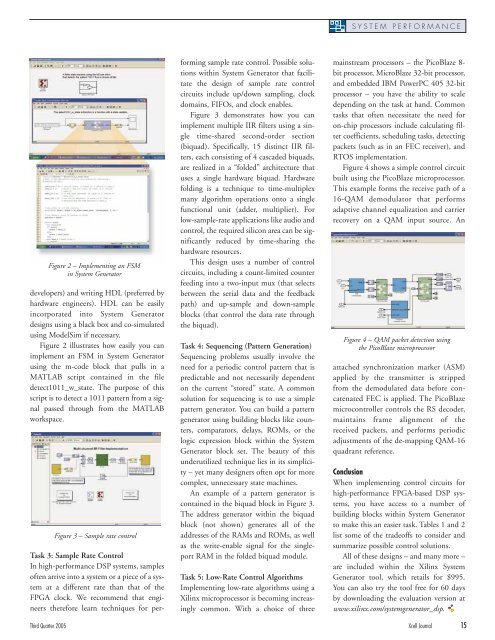Design Challenges: Avoiding the Pitfalls, winning the game - Xilinx
Design Challenges: Avoiding the Pitfalls, winning the game - Xilinx
Design Challenges: Avoiding the Pitfalls, winning the game - Xilinx
You also want an ePaper? Increase the reach of your titles
YUMPU automatically turns print PDFs into web optimized ePapers that Google loves.
Figure 2 – Implementing an FSM<br />
in System Generator<br />
developers) and writing HDL (preferred by<br />
hardware engineers). HDL can be easily<br />
incorporated into System Generator<br />
designs using a black box and co-simulated<br />
using ModelSim if necessary.<br />
Figure 2 illustrates how easily you can<br />
implement an FSM in System Generator<br />
using <strong>the</strong> m-code block that pulls in a<br />
MATLAB script contained in <strong>the</strong> file<br />
detect1011_w_state. The purpose of this<br />
script is to detect a 1011 pattern from a signal<br />
passed through from <strong>the</strong> MATLAB<br />
workspace.<br />
Figure 3 – Sample rate control<br />
Task 3: Sample Rate Control<br />
In high-performance DSP systems, samples<br />
often arrive into a system or a piece of a system<br />
at a different rate than that of <strong>the</strong><br />
FPGA clock. We recommend that engineers<br />
<strong>the</strong>refore learn techniques for per-<br />
forming sample rate control. Possible solutions<br />
within System Generator that facilitate<br />
<strong>the</strong> design of sample rate control<br />
circuits include up/down sampling, clock<br />
domains, FIFOs, and clock enables.<br />
Figure 3 demonstrates how you can<br />
implement multiple IIR filters using a single<br />
time-shared second-order section<br />
(biquad). Specifically, 15 distinct IIR filters,<br />
each consisting of 4 cascaded biquads,<br />
are realized in a “folded” architecture that<br />
uses a single hardware biquad. Hardware<br />
folding is a technique to time-multiplex<br />
many algorithm operations onto a single<br />
functional unit (adder, multiplier). For<br />
low-sample-rate applications like audio and<br />
control, <strong>the</strong> required silicon area can be significantly<br />
reduced by time-sharing <strong>the</strong><br />
hardware resources.<br />
This design uses a number of control<br />
circuits, including a count-limited counter<br />
feeding into a two-input mux (that selects<br />
between <strong>the</strong> serial data and <strong>the</strong> feedback<br />
path) and up-sample and down-sample<br />
blocks (that control <strong>the</strong> data rate through<br />
<strong>the</strong> biquad).<br />
Task 4: Sequencing (Pattern Generation)<br />
Sequencing problems usually involve <strong>the</strong><br />
need for a periodic control pattern that is<br />
predictable and not necessarily dependent<br />
on <strong>the</strong> current “stored” state. A common<br />
solution for sequencing is to use a simple<br />
pattern generator. You can build a pattern<br />
generator using building blocks like counters,<br />
comparators, delays, ROMs, or <strong>the</strong><br />
logic expression block within <strong>the</strong> System<br />
Generator block set. The beauty of this<br />
underutilized technique lies in its simplicity<br />
– yet many designers often opt for more<br />
complex, unnecessary state machines.<br />
An example of a pattern generator is<br />
contained in <strong>the</strong> biquad block in Figure 3.<br />
The address generator within <strong>the</strong> biquad<br />
block (not shown) generates all of <strong>the</strong><br />
addresses of <strong>the</strong> RAMs and ROMs, as well<br />
as <strong>the</strong> write-enable signal for <strong>the</strong> singleport<br />
RAM in <strong>the</strong> folded biquad module.<br />
Task 5: Low-Rate Control Algorithms<br />
Implementing low-rate algorithms using a<br />
<strong>Xilinx</strong> microprocessor is becoming increasingly<br />
common. With a choice of three<br />
SYSTEM PERFORMANCE<br />
mainstream processors – <strong>the</strong> PicoBlaze 8bit<br />
processor, MicroBlaze 32-bit processor,<br />
and embedded IBM PowerPC 405 32-bit<br />
processor – you have <strong>the</strong> ability to scale<br />
depending on <strong>the</strong> task at hand. Common<br />
tasks that often necessitate <strong>the</strong> need for<br />
on-chip processors include calculating filter<br />
coefficients, scheduling tasks, detecting<br />
packets (such as in an FEC receiver), and<br />
RTOS implementation.<br />
Figure 4 shows a simple control circuit<br />
built using <strong>the</strong> PicoBlaze microprocessor.<br />
This example forms <strong>the</strong> receive path of a<br />
16-QAM demodulator that performs<br />
adaptive channel equalization and carrier<br />
recovery on a QAM input source. An<br />
Figure 4 – QAM packet detection using<br />
<strong>the</strong> PicoBlaze microprocessor<br />
attached synchronization marker (ASM)<br />
applied by <strong>the</strong> transmitter is stripped<br />
from <strong>the</strong> demodulated data before concatenated<br />
FEC is applied. The PicoBlaze<br />
microcontroller controls <strong>the</strong> RS decoder,<br />
maintains frame alignment of <strong>the</strong><br />
received packets, and performs periodic<br />
adjustments of <strong>the</strong> de-mapping QAM-16<br />
quadrant reference.<br />
Conclusion<br />
When implementing control circuits for<br />
high-performance FPGA-based DSP systems,<br />
you have access to a number of<br />
building blocks within System Generator<br />
to make this an easier task. Tables 1 and 2<br />
list some of <strong>the</strong> tradeoffs to consider and<br />
summarize possible control solutions.<br />
All of <strong>the</strong>se designs – and many more –<br />
are included within <strong>the</strong> <strong>Xilinx</strong> System<br />
Generator tool, which retails for $995.<br />
You can also try <strong>the</strong> tool free for 60 days<br />
by downloading <strong>the</strong> evaluation version at<br />
www.xilinx.com/systemgenerator_dsp.<br />
Third Quarter 2005 Xcell Journal 15

















